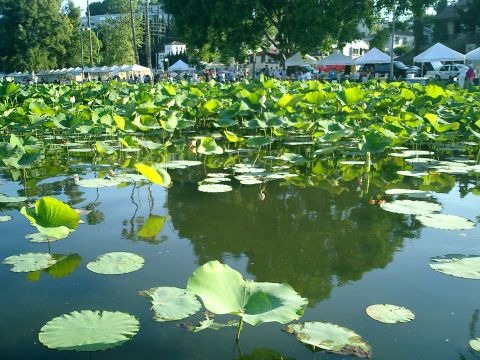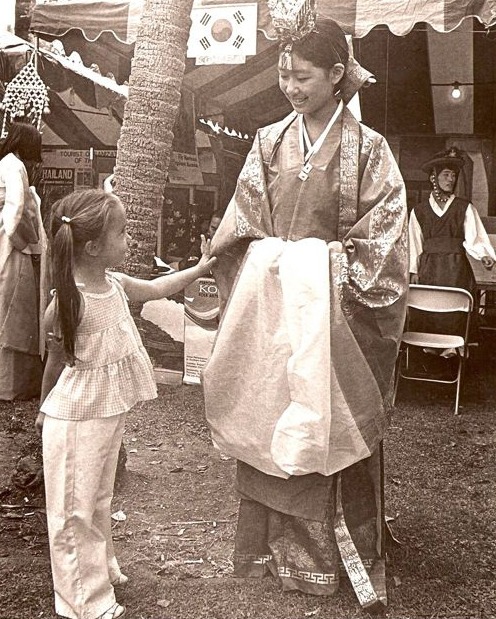Brief History of the Lotus Festival
Since we didn’t publish our usual “Flashback Friday” history post yesterday, with the Lotus Festival going on I thought it’d be a good opportunity to do a quick history of the Fest.
The Lotus Festival started out being called “The Day of the Lotus,” and debuted at Echo Park Lake in 1972 thanks to the Department of Recreation and Parks and members of the Council of Oriental Organizations (COO). Each festival takes place in July, timed for the blooming of the lotus flowers. Starting out as one-day affairs, the Day of the Lotus was designed to promote awareness of the contributions by Asian Americans to our culture and communities. The festival focuses on a different Asian ethnicity each year, this year they will showcase the Chinese culture.
The Festival was renamed “Lotus Festival” in 1990, and include the theme: “The Peoples and Culture of the Pacific Rim.” In 1991 the Lotus Advisory Board was developed, and included representatives from various Asian and Pacific Island communities.
I’m not sure when the dragon boat races began exactly, but the Dragon Boat website says it started when “the festival had a Chinese opening day ceremony.”
The origin of the lotus themselves are murky. Possible mentions of the lotus bed goes back as early as 1891, when development of the actual park first began (fun fact – it was first a reservoir and cost $5,637.00 to fill the newly formed lake with city water). However, that is not confirmed, and it’s more likely they showed up in 1923 or 1924. I have also read accounts of there maybe being two beds of lotus plants in the lake instead of just one.
Though there are rumors about the origins of the plants themselves (including that the Angeles Temple missionaries planted them using seeds from China), noone knows really where they came from or when. According the LA Parks website, the existing lotus plants in the lake are assumed to be “biologically linked to the original plants” as they are unaware of any supplemental planting since the original bed was created.
Even though the lotus flowers in Echo Park Lake were often considered the largest outside of Asia, the Echo Park Historical Society notes it’s only the largest in the Western U.S., citing larger beds in “the Carolinas, Hawaii and possibly Florida.”
The last couple of years have been difficult for the Lotus Festival. In 2007, the Lotus bed seemed to be dying off, and now are completely gone probably due to pollution and temperature changes. Last year the Lotus Festival was canceled due to city budget cuts, instead the community held the Echo Park Community Festival. When the city rebuilds Echo Park Lake, starting construction in April 2011, the Lotus bed will be a part of the rehab. You can also read a fact sheet from the Dept. of Parks and Rec about why the lotus went in decline and what they’re doing about by clicking here (for instance, they planted nine tubers this year to see if they will grow).
Thank you to “La Angelena” of LAHistory on Twitter for the photos – it’s been hard finding pictures of the early days of the Lotus Festival!




Research your particular species to make sure you’re providing best mild.
If they are losing leaves or look swollen, strive reducing their
water intake.
Let’s undergo the following and confirm
overwatering is the main hassle.
Succulents are generally small plants with a shallow root system.
Compost enriches the soil naturally so the roots are wholesome & the plants grow stronger.
Many individuals also really feel that a good clay
or ceramic pot simply plain seems higher than a plastic pot.
If any roots appear useless and dried out, they are often pruned
off.
Although you should usually wait 2-four days to mist them once more, this can be totally
different for each succulent.
When the roots are dry utterly, plant them back within the pot.
Succulentsare vegetation that retailer water in their
stems, roots, and leaves.
In my experience, there are a lot of problems caused when succulents are watered
from the highest down like odd potted vegetation.
Typically, they last longer when planted in soil rather than when glued on or placed in sphagnum moss or coir supplies.
Problems arise in wetter or more humid climates when soils don’t dry out in between water functions.
Every single recognized Pelotilla de Chinamada grows in an space that is solely about 1 km² (0.386 mi²) in dimension.
Dig a shallow hole in the new soil, place your succulent in it,
then gently cowl the roots with extra of the potting soil to stabilize the plant.
If you employ a water softener in your house, the excess salts can even injury your succulents.
Giving them a ‘full dose’ of water after an extended time period without water
might injury the vegetation.
Considerable progress could be seen in about four-6 months.
For most, the interval of growth is from Spring
into Fall.
Hardy succulents are those that can take temperatures under freezing and down to about -20
º F.
Succulents need soil that drains, so common potting soil—or
dust out of your yard—gained’t do.
Check out my resource web page for suggestions on the place to buy these and succulent cuttings online.
They should be packed very fastidiously and tightly, then shipped actually quickly to keep away from any harm.
Soil stored too wet prevents air from reaching the
roots, they usually die, resulting in soft rot.
Just like us, succulents need more vitality after they’re in a period of development.
Mini succulents can keep in small pots wherever from a few weeks to some
months, or even years.
When you water, apply enough so it runs out drainage holes.
When given the right care they will stay
for a very long time, from a number of months to even years in the same pot
or container.
And, should you haven’t already, don’t neglect
to download my free cheat sheet to see what it
looks like when your succulents need more or less water.
Personally, I chose to plant succulents for my indoor garden, but they
adapt properly, even outdoor too.
After just two or three days with an excessive amount of water,
these lovely rosettes shall be on a fast observe
to rot.
For most, the interval of growth is from Spring into Fall.
South- and east-facing windows will get essentially the most
direct sunlight, so long as there are no obstructions.
First of all, it’s essential to understand that dying leaves are a pure part
of every plant’s life — and succulents are
no exception.
It does need water, however it has no stay roots and may’t
take water up.
The Aeonium gorgoneum, which is known as Salão by the native inhabitants on the Cape Verde Islands, is
a rare succulent that is vulnerable to over harvesting.
Caring for a mini succulent backyard entails correct watering techniques,
the best soil medium, and enough sunlight.
To water succulents, give them an intensive soaking each
time the soil feels dry.
If the roots are fully rotten, remove all of them and part of the stem
that’s puckered and has black or brown spots.
Cactiare simply a household, or sub-class throughout the group of
vegetation collectively known assucculents.
Succulents like it when soil approaches dry earlier than being watered.
Soil stored too moist prevents air from reaching the roots, and so they die,
resulting in soft rot.
But, Echeveria varieties prefer to be exterior with lots of daylight.
The finest way to avoid over-watering is to ensure your soil
is totally dried out before watering once more.
Shipping could be a bit expensive, particularly for plants.
While most succulents survive nicely in a sunny spot with little upkeep,
some are higher suited to the outside than growing indoors as houseplants.
Brush the potting soil down the internal sides of the dish so that there is
no roaming dirt.
A few other materials that can be utilized include pearlite, porous crushed rock, as well as lava
fines.
Especially if you tend to over water, this soil will certainly
aid your succulents flourish!
Search for succulents with different heights and
structures to add rate of interest to the bowl.